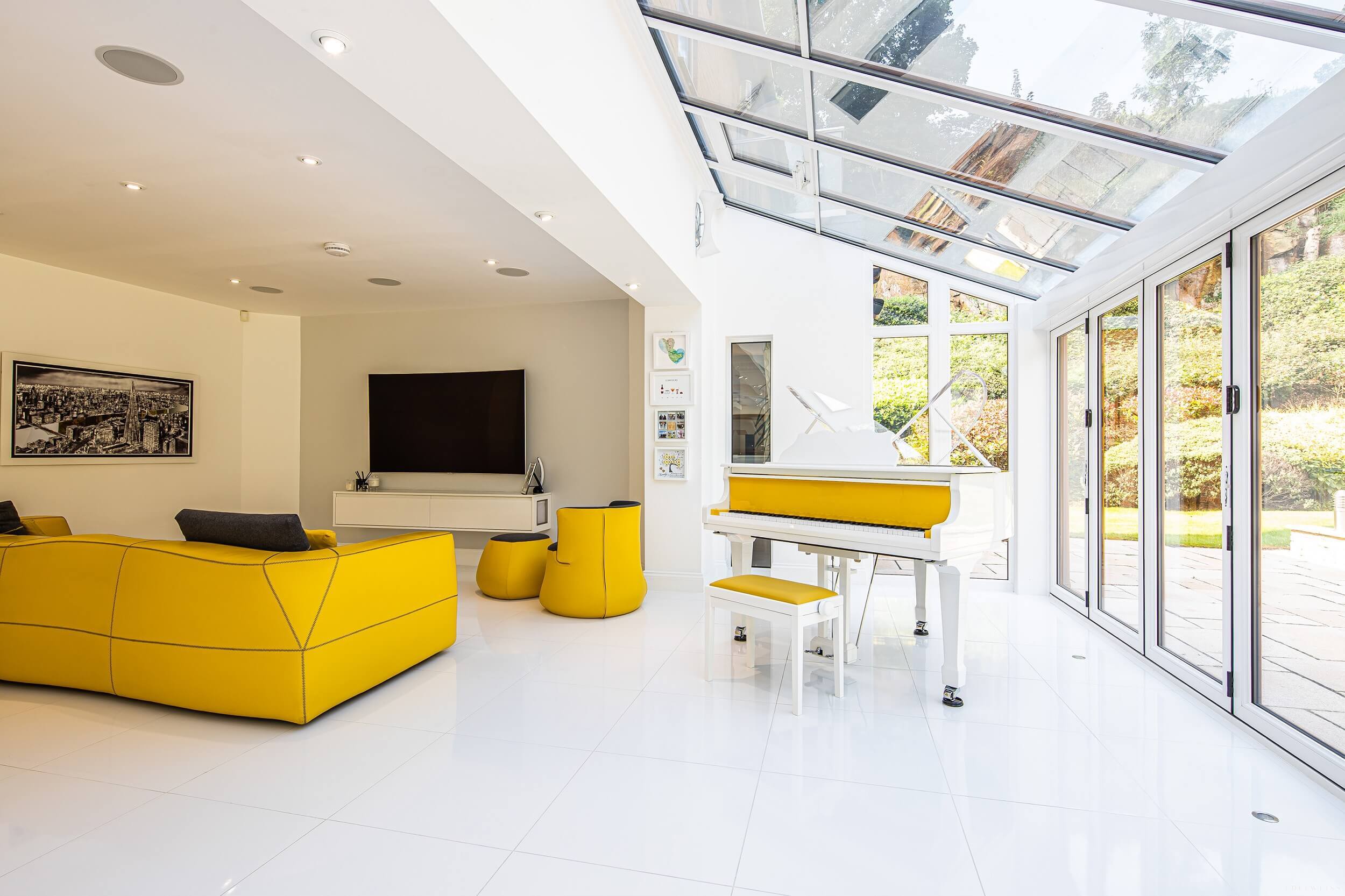Table of Contents

A Brief History Of Self-Playing Pianos
Self-playing pianos have a rich history that spans over a century. These innovative instruments blend mechanical, electrical, and digital technologies to bring music to life without a pianist. Here, you’ll discover key milestones that have shaped the evolution of self-playing pianos.
1895: Introduction of the Pianola
In 1895, Edwin Votey invented the first self-playing piano, called the Pianola. This groundbreaking device used paper rolls with perforated holes to control the piano keys. As the roll moved over a tracker bar, air activated the corresponding notes, creating music. The Pianola quickly became a popular fixture in homes and public places.
The Roaring Twenties
By the early 20th century, the Pianola became emblematic of the “roaring twenties” in the United States. This era, marked by cultural dynamism and economic prosperity, saw a surge in the Pianola’s popularity. Owning a self-playing piano was a status symbol, reflecting both technological advancement and cultural sophistication.
The Welte Reproducing Piano
Innovations continued with the introduction of the Welte reproducing piano by the German company Welte-Mignon. This model featured an electric suction pump and an expression control mechanism, allowing it to capture and replicate the nuances of a pianist’s performance. The Welte reproducing piano set a new standard in the accuracy and expressiveness of self-playing pianos.
Modern Advancements
Today, self-playing pianos use cutting-edge digital technology to deliver unparalleled musical experiences. Brands like Steinway Spirio, Yamaha Disklavier, PianoDisc, and QRS dominate the market. These modern instruments offer various features, such as remote control via smartphones and integration with digital music libraries, making them more versatile and user-friendly than ever before.
The evolution of self-playing pianos showcases a fascinating blend of artistry and technology. From the mechanical ingenuity of the Pianola to the digital sophistication of today’s models, these instruments continue to captivate and inspire music lovers worldwide.
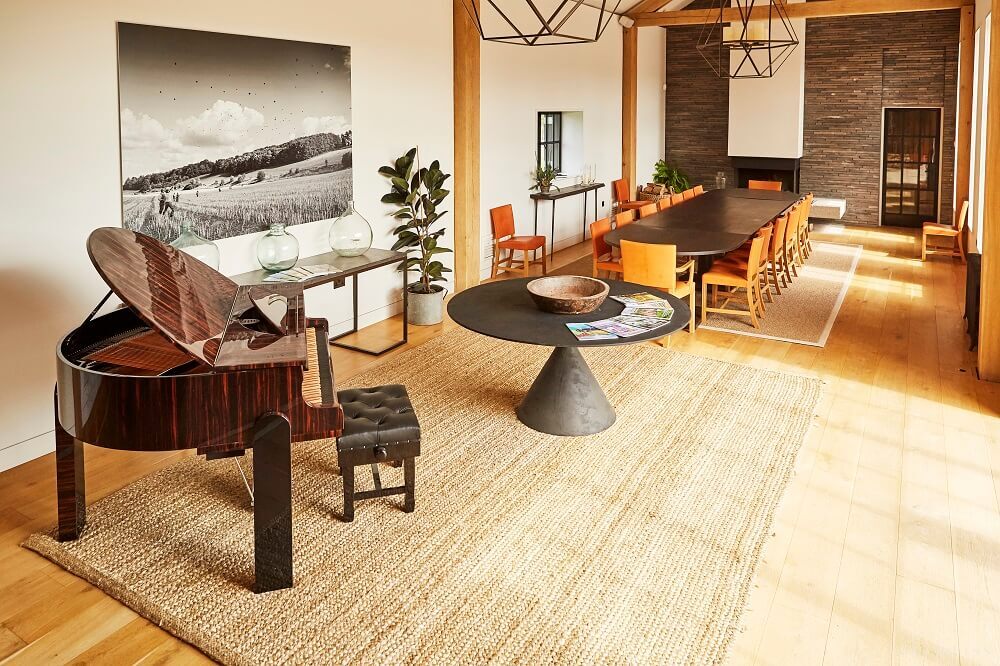
How Self-Playing Pianos Work
Self-playing pianos, also known as player pianos, perform music autonomously thanks to installed mechanisms. They blend acoustic piano features with advanced technology, offering convenience and entertainment.
The sound of a self-playing acoustic grand piano is always the acoustic sound – not a digital or recorded sound.
Key Components
Two main components help the operation of self-playing pianos:
1. Mechanism: Inside every self-playing piano, an intricate system uses electromagnetic solenoids. These solenoids push the piano keys from beneath, mimicking a pianist’s finger movements. Each solenoid features more than 1,800 gradations of force, enabling precise control over dynamics and articulation.
2. Recording and MIDI Files: The music originates from performances by professional pianists captured on acoustic pianos fitted with special technology to capture the touch and dynamics of the pianist. These recordings convert into MIDI files that encode detailed information about the notes played, including speed and force. The self play system then utilizes these MIDI files to recreate performances with high fidelity, ensuring the playback sounds as realistic as possible.
How A Self-Playing Piano Works
Read an indepth explaination here including diagrams and animated examples.
Click Here
The Role of Technology
Technology enhances self-playing pianos with added functionality and connectivity:
-
Digital Interfaces: Modern self-playing pianos often feature digital interfaces, allowing you to control the piano through apps on smartphones or tablets. This connectivity lets you access an extensive library of songs and control playback settings remotely.
-
Software Integration: Software plays a significant role in optimizing performance. Advanced algorithms analyze MIDI data to ensure accurate reproduction of the original performance.
-
High-Resolution Data: High-resolution MIDI files contain detailed performance nuances that standard files might lack. These files ensure every subtlety of the original performance is preserved.
-
Recording Capabilities: Some self-playing pianos can also record your performance. This feature is useful for practice and professional recording purposes allowing pianists to review and perfect their performances.
-
Educational Tool: They provide valuable teaching tools, offering students the chance to play along with professional recordings and observe subtle details in technique and timing.
-
Home Entertainment: They serve as entertainment centers, providing live piano recitals at home without needing a pianist.
-
Event Hosting: Ideal for hosting events or gatherings by providing high-quality musical performances without needing a live performer.
-
Musician Support: They support musicians by facilitating composition, rehearsal, and performance review, offering playback of complex pieces with precision.
Self-playing pianos seamlessly integrate tradition and innovation, providing versatile benefits for music enthusiasts.

Choosing The Right Self-Playing Piano
Finding the perfect self-playing piano involves understanding your needs and preferences. Balancing sound quality, design features and your space will guide you to the right choice.
Digital Self-Playing Pianos
Digital self-playing pianos offer several advantages. They are lightweight and compact, making them easy to move and place. Maintenance is minimal since they don’t need tuning. They produce various sounds and timbres and often come with built-in recording capabilities and MIDI connectivity. You can play them silently using headphones. Generally, they are more affordable than acoustic pianos.
But, digital self-playing pianos might lack the authentic feel and sound of an acoustic piano. The dynamic range and nuance in touch response might be limited compared to acoustic pianos.
The sound from a digital self-playing piano is always a digital-pre recorded sound.
Acoustic Self-Playing Pianos
Acoustic self-playing pianos provide a rich, authentic sound and playing experience. The depth of sound and touch response create a superior musical experience. Many musicians prefer acoustic pianos for their natural resonance and physical feedback.
Nevertheless, acoustic self-playing pianos are heavier and larger, making them less portable. Regular maintenance, including tuning, is necessary to keep them in optimal condition. They are generally more expensive than digital counterparts.
The sound from an acoustic self-playing piano is always acoustic – it is never digital.
Key Features to Consider
Considering these key features will help you make a well-informed choice.
Sound Quality
Sound quality is a crucial factor. Acoustic pianos offer a fuller, more resonant sound due to their physical components. Digital pianos replicate sounds through speakers, which may not capture the same depth.
Touch Sensitivity
Touch sensitivity impacts your playing experience. Acoustic pianos naturally provide a nuanced touch response. Some high-end digital pianos offer graded hammer action to mimic this, but it’s essential to try them out.
Connectivity
Modern self-playing pianos often include connectivity options. Digital pianos typically feature MIDI and USB connections, which are great for recording and producing music. Acoustic pianos might have built-in systems that connect to apps or external devices.
Budget
Budget constraints can significantly influence your choice. Digital pianos are often less costly than acoustic ones. Consider the long-term investment, including maintenance costs for acoustic pianos or potential upgrades for digital pianos.
Space
Space considerations are vital. Digital pianos are more compact and easier to fit into smaller rooms. Acoustic pianos require more space and a stable environment.
Additional Features
Additional features add value. Look for built-in song libraries, learning tools, and interactive apps in digital pianos. Acoustic pianos might offer enhanced recording systems and better integration with smart devices.
Considering these aspects ensures you choose a self-playing piano tailored to your needs and preferences.
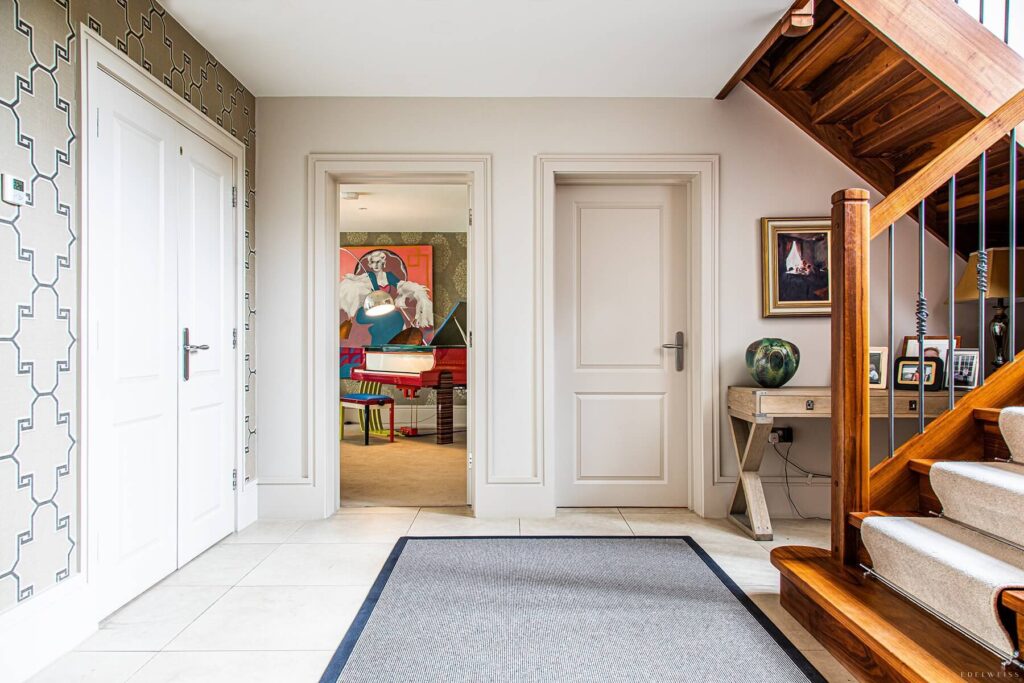
Costs and Budgeting
Understanding the costs and budgeting factors for self-playing pianos helps you make an informed purchase decision. Evaluating price ranges and knowing the elements affecting the cost ensures you find the right piano within your budget.
Price Range Overview
Self-playing pianos, also known as player pianos, cover a broad price spectrum. They cater to various needs and preferences, from beginner models to luxurious high-end options. Here are the main price categories:
Entry-level: Ranging from $1,000 to $15,000, entry-level self-playing pianos typically offer basic features and are only digital pianos at this price range if buying something new. These models suit beginners or individuals who don’t want to make a significant financial investment. An example is the Yamaha Clavinova CSP-150, which provides decent sound quality and beginner-friendly features.
Mid-range: Priced between $15,000 and $60,000, mid-range pianos offer enhanced functionalities and better sound quality. These models often include advanced recording options, connectivity features, and improved mechanics. The Yamaha Disklavier Enspire ST is a notable example, offering a blend of advanced features and moderate pricing.
High-end: Costing $70,000 to $150,000+ high-end models boast superior build quality, premium materials and sophisticated design features. These pianos are designed for serious musicians and enthusiasts seeking the best possible playing and listening experience. A prime example is the Edelweiss S132 Piano, the ultimate home performance grand piano which offers exceptional sound quality and cutting-edge technology making it a joy to play and delight to listen to – made for the home environment.
Custom-Made Pianos: If you want to be completely unique and have the ultimate in bespoke design then a bespoke Edelweiss Player Piano design is for you. Choose this option and you can sit down with the Edelweiss studio and craft a design specific to you. Your imagination will determine the budget for this option. Edelweiss Pianos are the leading makers of bespoke pianos and specialize in creating bespoke, custom pianos that aren’t just another black piano!
Factors Affecting Cost
Several variables impact the cost of self-playing pianos, influencing your ultimate decision. Understanding these factors helps you choose a piano that meets your needs and fits within your budget.
-
Materials: High-quality materials like premium woods and advanced electronic components significantly increase the price of self-playing pianos along with the build process – being hand-made. For instance, pianos that are hand-made with solid spruce soundboards, the finest felt hammers, and hand-built components typically cost more due to their superior sound quality and durability.
-
Age: Brand new pianos generally cost more than older ones, largely due to technological advancements and contemporary design features. But, well-maintained older pianos can still command high prices, especially if they possess unique or rare qualities.
-
Brand: Brands play a crucial role in determining the price of self-playing pianos. Renowned brands like Edelweiss, Steinway & Sons, Fazoli are often more expensive because of their reputation for quality and reliability.
-
Features: The number and complexity of features also affect the cost. Pianos with advanced recording capabilities, extensive music libraries, Wi-Fi connectivity, and mobile app integration tend to be pricier. A piano equipped with playback editing and dynamic playback features offers more versatility but at a higher cost.
By considering these factors, you can navigate through the multitude of options and select a self-playing piano that aligns with your musical aspirations and financial constraints.
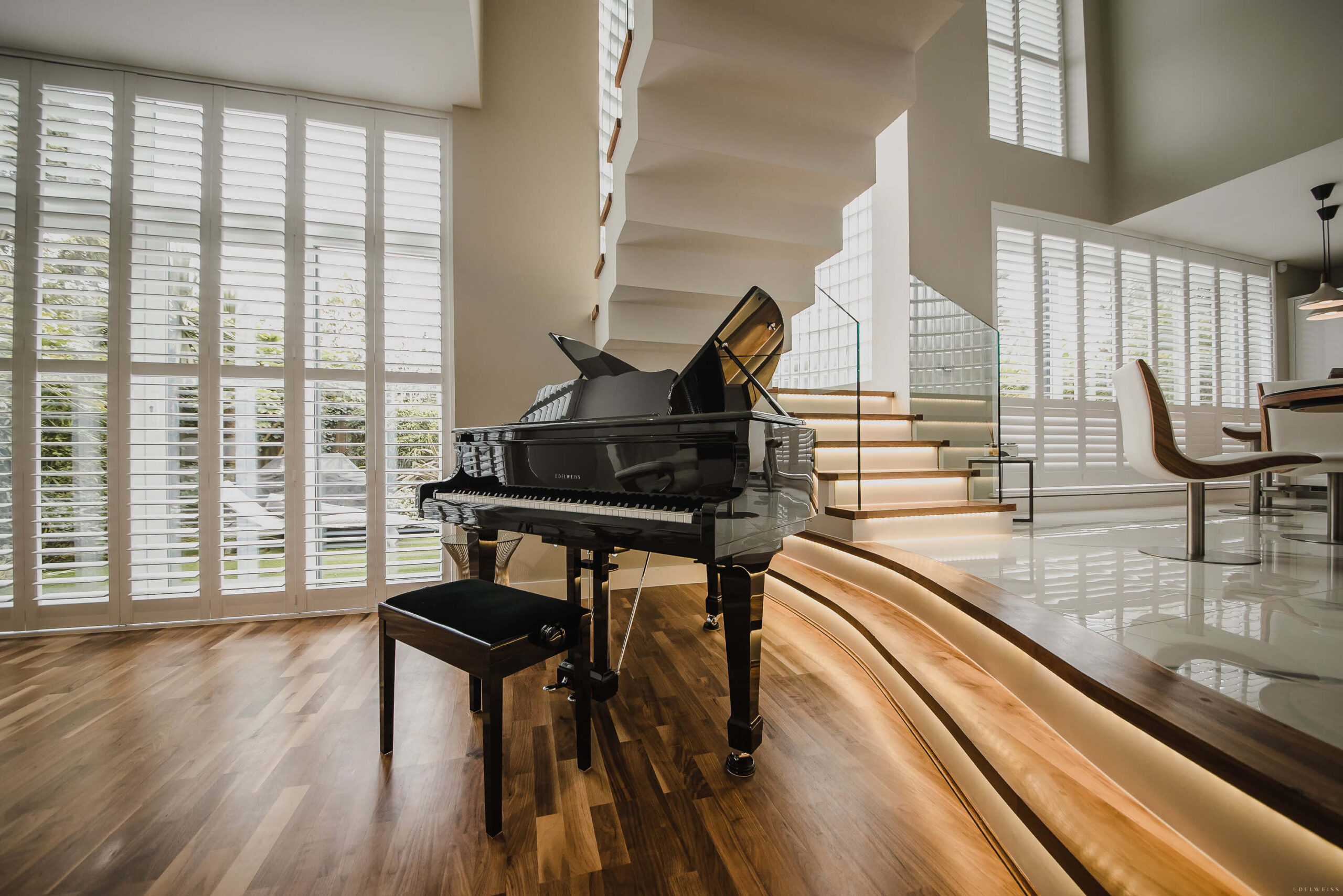
Benefits Of Self-Playing Pianos
Enhancing Musical Experience
Self-playing pianos offer various ways to elevate your musical engagement.
-
Improved Mood and Self-Esteem: Listening to or interacting with self-playing pianos can boost your mood and reduce stress. This helps foster a positive emotional state, which can enhance overall self-esteem. Research indicates that music can trigger the release of dopamine, a neurotransmitter associated with pleasure.
-
Cognitive Development: Engaging with self-playing pianos can improve cognitive skills like memory, spatial-temporal ability, and language development. Studies have shown that musical activities, including exposure to self-playing instruments, can stimulate brain regions involved in these functions. This benefit is particularly valuable for children and the elderly.
Entertainment Value
Self-playing pianos add significant entertainment value to social gatherings and personal relaxation.
-
Social Gatherings: Self-playing pianos provide an excellent source of entertainment for parties and gatherings. They offer the ability to play complex compositions without the need for a skilled pianist, impressing guests and creating a sophisticated atmosphere.
-
Personal Relaxation: Using self-playing pianos for personal enjoyment allows you to unwind with your favorite music. They can also simulate the feeling of having live performances in your own home, adding a touch of luxury and relaxation to your daily routine.
-
Regular Maintenance: Ensure that the piano remains in top condition by following the manufacturer’s maintenance guidelines. Regular tuning and software updates are critical to maintaining performance quality
-
Diverse Repertoire: Explore a wide range of musical genres to maximize the benefits of your self-playing piano. From classical to contemporary pieces, a diverse selection can keep your experience fresh and engaging
-
Educational Tools: Use the educational features included in many modern self-playing pianos. These can offer tutorials, sheet music synchronization, and interactive learning modules, making it easier to learn and appreciate music.
By understanding these benefits, you can fully use the capabilities of self-playing pianos to enhance your musical and educational experiences.

Popular Brands
Edelweiss Pianos
An Edelweiss is a piano that is hand-built in Britain, made for the home and designed to be different. As standard, the Edelweiss Virtuoso Self-Play system is fitted to every Edelweiss Piano they build in their workshops in Cambridge, UK unlike other manufacturers where you have to buy a certain model to get the self-play function. Viewed as the leading maker of bespoke grand pianos for the home – an Edelweiss Piano is the aspired after brand when it comes to bespoke self-playing grand pianos.
With advanced recording and playback capabilities if required and it’s beautiful sonorous European tone – for professionals and enthusiasts alike – the Edelweiss is the ultimate Home Performance Grand Piano – you won’t find an Edelweiss in a concert hall.
Steinway Spiro
Steinway has a great legacy and are known for their excellent craftsmanship and distinct sound due to the size of the pianos they build. The Spirio is the self-playing model of Steinway’s offering and includes recording and playback capabilities. Steinway’s legacy is making some of the best pianos in the world and is a popular choice for professional pianists used to performing on their large grand pianos in a concert hall and Spirio system offers advanced features in record and playback as a result of this. This means you can experience a live performances being played real time in a concert hall on your piano live in your own home.
Yamaha Disklavier
Yamaha’s Disklavier series stands out due to its exceptional technology and versatility. Yamaha are production line pianos – so not built by hand like an Edelweiss or Steinway and are at a more affordable price range. The Enspire collection, for example, starts at £23,000 and integrates state-of-the-art features that allow performances to be transferred into MIDI format. These pianos are perfect for both home enjoyment and professional use, providing a seamless blend of traditional piano playing with modern technology.
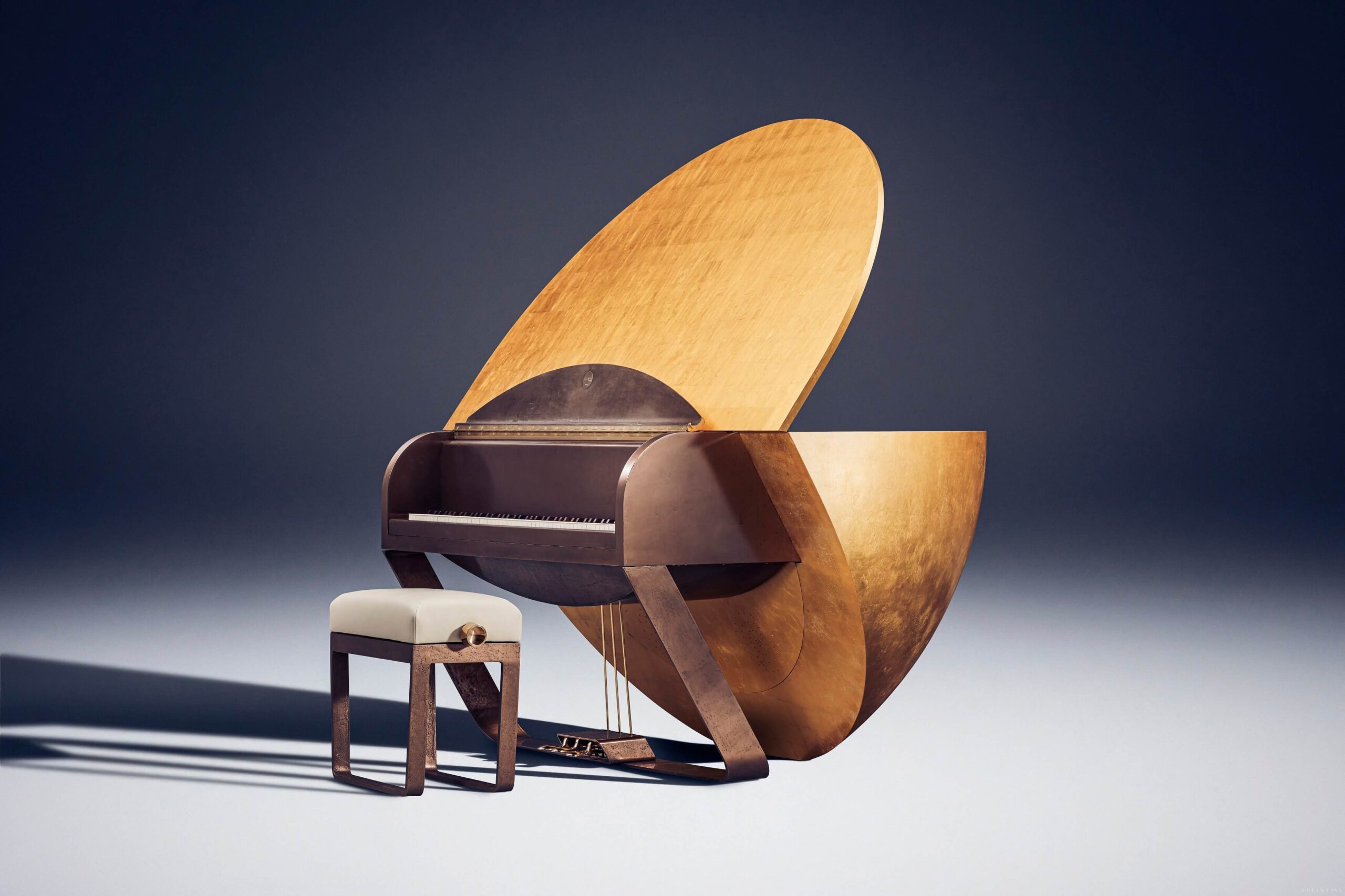
Self Playing Pianos as a rooms centerpiece.
Choosing a self-playing piano as the focal point of a room can transform your living space into a blend of elegance and technology. These pianos serve not only as musical instruments but also as statement pieces, enhancing both auditory and visual appeal.
Aesthetic Appeal
Self-playing pianos, particularly grand pianos, exude a classic, timeless elegance that can elevate the décor of any room. Modern designs from brands like Edelweiss and Steinway offer sleek finishes and subtle detailing, making them suitable for both traditional and contemporary interiors. For instance, the Edelweiss Transparent S132 is made of transparent parts including the case, providing a stunning visual impact when placed in a well-lit room.
Spatial Considerations
When positioning a self-playing piano, consider its size and the room’s layout. A grand piano requires more space and works well in larger rooms or open floor plans. Upright models like the Yamaha Disklavier Upright Series can fit into smaller spaces without sacrificing audio quality or functionality. Ensure the piano has adequate space around it to allow the sound to resonate properly, enhancing the auditory experience.
Creating Ambiance
A self-playing piano can create various ambiances, making it perfect for different occasions. For an evening gathering, set the piano to play soft classical pieces from an extensive MIDI library, fostering a sophisticated atmosphere. During family time, opt for lively, upbeat tunes to energize the room. Personalized playlists can cater to different moods and events, making the piano a versatile entertainment source.
Integrating Technology
Modern self-playing pianos incorporate advanced technology, making them more than just musical instruments. Features like Wi-Fi connectivity and app control allow you to manage the piano remotely. You can schedule performances, adjust volumes, and even download new song libraries directly to the piano. This tech-savvy integration ensures your self-playing piano remains a highlight in a smart home.
Enhancing Social Gatherings
A self-playing piano can act as the centerpiece in social gatherings, sparking conversations and interactions. Guests can enjoy live music without needing a pianist, and the piano can play a curated soundtrack suited to your event. Whether it’s background music during a dinner party or a lively tune at a celebration, the piano ensures a memorable experience.
Investment Value
Investing in a high-quality self-playing piano increases your property’s aesthetic and market value. Recognized brands like Steinway and Edelweiss are known for their durability and craftsmanship, ensuring that the piano remains a treasured asset over time. The blend of tradition and modern technology makes these pianos desirable to prospective buyers if you decide to sell your home.
Practical Tips for Placement
-
Lighting: Position your piano in a well-lit area to highlight its visual features. But, avoid direct sunlight as it can damage the piano’s finish.
-
Acoustics: Consider carefully what surfaces you put the piano on. A hard surface like wood or tile can enhance the sound resonance and carpet can reduce the sound resonance.
-
Climate: Ensure the piano is in an environment where the humidity levels can be controlled – i.e not a conservatory.

Maintenance and Care
Regular maintenance and care are vital to keep your self-playing piano in optimal condition. Follow these practices for longevity and performance.
Tuning
Consistent tuning ensures your piano produces the best sound. Tune your self-playing piano at least once a year. For instruments played frequently or those that are new, consider biannual or quarterly tuning. This keeps the piano’s pitch accurate and prevents string tension issues.
Pedal Adjustment
Pedals contribute to the piano’s expressive capabilities. Have a professional technician check pedal alignment and responsiveness. Adjustments might be necessary to maintain proper functionality, especially if the pedals feel stiff or unresponsive.
Cleaning
Dust and dirt can affect your piano’s mechanics and sound quality. Regularly dust the exterior with a soft cloth. Use a slightly damp cloth for keys. Avoid chemical cleaners, as they can damage the finish and internal components. Also, keep liquids away from the piano to prevent spills.
Temperature and Humidity Control
Pianos are sensitive to environmental changes. Maintain a stable temperature and humidity level (around 42-55% RH) to prevent wood warping and mechanical issues. Dehumidifiers or humidifiers can help, depending on your climate. Using a hygrometer lets you monitor these levels accurately.
Inbuilt System Maintenance
The self-playing mechanism requires periodic servicing. Consult the manufacturer for specific guidelines, as maintenance routines vary by brand and model. Typically, this includes software updates and mechanical check-ups to ensure synchrony and performance.
Storage and Placement
Proper placement affects your piano’s longevity. Avoid placing it near windows or external walls to minimize exposure to direct sunlight, temperature fluctuations, and moisture. Use a piano cover for added protection when not in use.
Professional Inspections
Have a qualified technician perform annual inspections. They can identify potential issues and provide recommendations to prevent major repairs. Regular professional assessments safeguard both the acoustic and technological aspects of your self-playing piano.
Key and Sensor Care
Sensors in self-playing pianos require delicate handling. Clean keys gently and avoid using excessive force when playing manually. This helps in prolonging sensor life and maintaining accurate note reproduction.
Common Issues and Solutions
Understanding common problems helps in timely resolution:
-
Sticking Keys: Clean the affected area and contact a technician if the issue persists.
-
Poor Sound Quality: This might indicate the need for tuning or internal adjustments.
-
Unresponsive Self-Playing Features: Check software updates or consult the manufacturer for troubleshooting steps.
-
Schedule regular maintenance with a certified piano technician.
-
Keep a log of repairs and services to track the piano’s condition.
-
Educate yourself on basic troubleshooting specific to your model.
-
Invest in a quality piano cover and climate control devices.
By following these guidelines, you’ll ensure your self-playing piano stays in excellent condition, delivering beautiful music and consistent performance for years.

Conclusion
Self-playing pianos beautifully blend tradition with modern technology, offering an exceptional musical experience for all. Whether you’re a seasoned musician or just beginning your musical journey, these instruments provide endless enjoyment and educational benefits.
By choosing the right model and maintaining it properly, you ensure it remains a cherished part of your life for years to come. Explore your options and let the magic of self-playing pianos enrich your world.
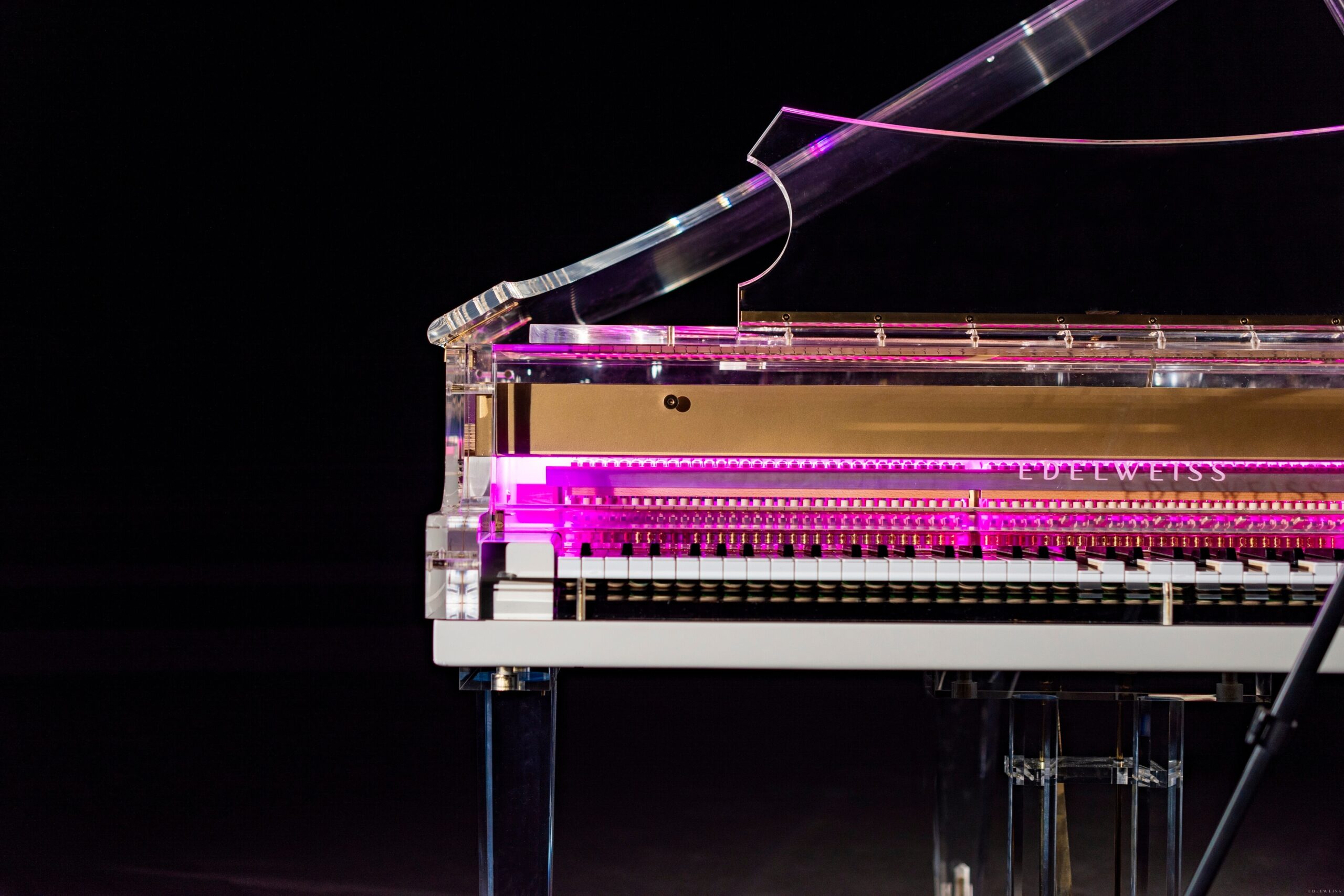
Frequently Asked Questions
What is a self-playing piano?
A self-playing piano, also known as a player piano, can play music automatically using pre-recorded media or digital files. It combines traditional piano mechanisms with advanced technology to reproduce live performances without a human player.
How does a self-playing piano work?
Self-playing pianos use built-in electronic systems or pneumatic mechanisms to move the keys and pedals. These systems read digital files or paper rolls and translate them into piano actions, replicating the exact notes and dynamics of a performance.
Which are popular models of self-playing pianos?
Popular models include the Edelweiss and Steinway models. They are known for their high-quality sound, advanced technology, and versatile features that cater to both professional musicians and casual enthusiasts.
What are the benefits of a self-playing piano?
Self-playing pianos enhance musical experiences, cognitive development, and educational growth. They are also great for entertainment, mood improvement, self-esteem, and personal relaxation, making them a valuable addition to homes and social settings.
How often should a self-playing piano be tuned?
Like traditional pianos, self-playing pianos should be tuned at least twice a year. Regular tuning ensures optimal sound quality and performance, preserving the instrument’s longevity.
How do I maintain a self-playing piano?
Maintenance involves regular tuning, pedal adjustment, cleaning, and controlling the piano’s environment. Ensure proper storage, perform system updates, and schedule professional inspections to keep the piano in top condition.
Can I play a self-playing piano manually?
Yes, self-playing pianos can be played manually like any traditional piano. The automatic playing system does not interfere with the normal acoustic functions of the piano.
Is it expensive to maintain a self-playing piano?
While the maintenance costs for self-playing pianos can be higher than those for traditional pianos due to the added technology, regular upkeep is essential. Investing in proper care reduces the risk of expensive repairs.
What should I do if my self-playing piano has technical issues?
Consult a professional technician for troubleshooting and repairs. Keep a repair log and familiarize yourself with basic troubleshooting techniques to handle minor issues.
Is it possible to convert a traditional piano into a self-playing one?
Yes, traditional pianos can be converted into self-playing pianos using the Edelweiss Virtuoso self-play system. These systems can be installed on virtually any piano, offering a range of features to enhance its capabilities.

